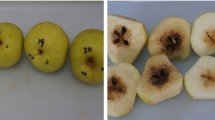Abstract
A rapid method to evaluate the amount of Lycium barbarum polysaccharides (LBPs) based on near-infrared diffuse reflectance spectroscopy (NIDRS) is proposed. A total of 114 dried L. barbarum samples from different regions of China were used for modeling by partial least squares (PLS) regression with the effective wavelengths (EWs) selected by correlation coefficients and X-loading weights. The PLS model worked best with EWs of 4003–5087, 5568–7002, and 7463–12,000 cm−1. These EWs were chosen by correlation coefficients after spectral pretreatment. Use of these EWs resulted in determination coefficients of calibration and validation of 0.982 and 0.938, respectively. The proposed model successfully predicted external samples, which further confirmed prediction ability of the model. Overall results indicated that both correlation coefficients and X-loading weights for EWs selection can improve model performance and that NIDRS can rapidly determine LBPs with intact particle samples.



Similar content being viewed by others
References
Bai Q, Chen S, Yan Y, Zhu Y, Dai J (2006) Prediction of ensiled maize quality traits with near Infrared diffuse reflectance spectroscopy (NIDRS). Sci Agric Sin 39:1346–1351
Barnes R, Dhanoa M, Lister SJ (1989) Standard normal variate transformation and detrending of near-Infrared diffuse reflectance spectra. Appl Spectrosc 43:772–777
Cen H, He Y (2007) Theory and application of near Infrared reflectance spectroscopy in determination of food quality. Trends Food Sci Technol 18:72–83
Chang C, Laird DA, Mausbach MJ, Hurburgh CR (2001) Near-infrared reflectance spectroscopy–principal components regression analyses of soil properties. Soil Sci Soc Am J 65:480–490
Chen Y, Xie M, Zhang H, Wang Y, Nie S, Li C (2012) Quantification of total polysaccharides and triterpenoids in Ganoderma lucidum and Ganoderma atrum by near infrared spectroscopy and chemometrics. Food Chem 135:268–275
Chen Y, Xie MY, Nie SP, Li C, Wang YX (2008) Purification, composition analysis and antioxidant activity of a polysaccharide from the fruiting bodies of Ganoderma atrum. Food Chem 107:231–241
Chu XL, Yuan HF, Lu WZ (2004) Progress and application of spectral data pretreatment and wavelength selection methods in NIR analytical technique. Prog Chem 16:528–542
Gierlinger N, Schwanninger M, Wimmer R (2004) Characteristics and classification of Fourier-transform near infrared spectra of the heartwood of different larch species (Larix sp.). J Near Infrared Spectrosc 12:113–119
Gong T, Wang X, Zhao L, Ma L (2010) Barbarumpolysaccharide antioxidant research. Biotechnology 1:031
Guadalupe Z, Martínez-Pinilla O, Garrido Á, Carrillo JD, Ayestarán B (2012) Quantitative determination of wine polysaccharides by gas chromatography–mass spectrometry (GC–MS) and size exclusion chromatography (SEC). Food Chem 131:367–374
Iñón FA, Llario R, Garrigues S, de la Guardia M (2005) Development of a PLS based method for determination of the quality of beers by use of NIR: spectral ranges and sample-introduction considerations. Anal Bioanal Chem 382:1549–1561
Jiang LY, Liu FL, Chen HC, Yin JF (2009) Selection of optical path length on nir analysis for tea polyphenols in green tea drinks. J China Univ Metrol 20(2):135–138
Li J, Du G, Kang J, Cai W, Shao X (2011) Determination of sunset yellow in carbonated drinks by anion exchange resin in combination with near Infrared diffuse reflectance spectroscopy. Chin J Anal Chem 6:030
Liu F, He Y, Wang L (2008) Determination of effective wavelengths for discrimination of fruit vinegars using near infrared spectroscopy and multivariate analysis. Anal Chim Acta 615:10–17
Lu G, Sheng H, Xiang L, Hui B (2004) Immunomodulation and antitumor activity by a polysaccharide–protein complex from Lycium barbarum. Int Immunopharmacol 4:563–569
Lu WZ, Yuan HF, Xu GT, Qiang DM (2000) Modern analytical techniques in near-infrared spectroscopy. China Petrochemical Press, Beijing
Min M, Lee W (2005) Determination of significant wavelengths and prediction of nitrogen content for citrus. Trans ASAE 48:455–461
Rambla F, Garrigues S, De La Guardia M (1997) PLS-NIR determination of total sugar, glucose, fructose and sucrose in aqueous solutions of fruit juices. Anal Chim Acta 344:41–53
Small GW (2006) Chemometrics and near-infrared spectroscopy: avoiding the pitfalls. TrAC, Trends Anal Chem 25:1057–1066
Wang C, Chang S, Chen B (2009a) Chromatographic determination of polysaccharides in Lycium barbarum Linnaeus. Food Chem 116:595–603
Wang F, Chen D, Shao XG (2002) Research on the nonlinear model of near infrared spectroscopy and the total sugar of tobacco samples. Tob Tech 5:23–26
Wang Y, Qin M, Qi J, Yu B, Tang L (2009b) Analysis of polysaccharides contents in Ophiopogon japonicus by NIR. Spectrosc Spectr Anal 29:2677–2680
Wang YB, Yuan HF, Lu WZ (2001) Determination on viscosity index of lube base oil by NIR. Tob Tech 16:53–56
Wang Z (2003) Study on active component from the fruit of Lycium Barbarum in different regions. Bull Bot Res 23:337–339
Yan H, Han B, Wu Q, Jiang M, Gui Z (2011) Rapid detection of Rosa laevigata polysaccharide content by near-infrared spectroscopy. Spectrochim Acta A Mol Biomol Spectrosc 79:179–184
Zhang W, Zhang L, Li J, Zhao L (2008) Quantity analysis of information decomposition for near-Infrared diffuse reflectance spectra. Spectrosc Spectr Anal 28:1790–1794
Acknowledgment
The authors would like to thank the Fundamental Research Funds for the Central Universities (QN 2013057) for the financial support.
Compliance with Ethics Requirements
ᅟ
Conflict of Interest
Yage Wang, Yuan Gao, Xiuzhu Yu, Yuanyuan Wang, Shan Deng, and Jinming Gao declare that they have no conflict of interest. This article does not contain any studies with human or animal subjects.
Author information
Authors and Affiliations
Corresponding author
Rights and permissions
About this article
Cite this article
Wang, Y., Gao, Y., Yu, X. et al. Rapid Determination of Lycium Barbarum Polysaccharide with Effective Wavelength Selection Using Near-Infrared Diffuse Reflectance Spectroscopy. Food Anal. Methods 9, 131–138 (2016). https://doi.org/10.1007/s12161-015-0178-7
Received:
Accepted:
Published:
Issue Date:
DOI: https://doi.org/10.1007/s12161-015-0178-7




